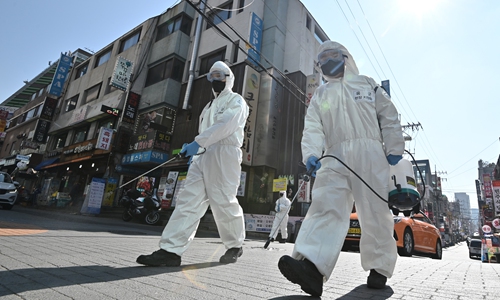
South Korean soldiers wearing protective gear spray disinfectant on the street to help prevent the spread of the COVID-19, at Gangnam district in Seoul on Thursday. South Korea's total number of novel coronavirus cases - the largest outside China - rose above 6,000. Photo: AFP
Without drastic lockdowns on a national or regional scale, South Korea, a country battling the worst coronavirus epidemic outside China, seems to be gradually taming the virus. Observers attributed the country's phased victory to its government's strong prevention measure and public cooperation.
However, experts said this model is not usable for most countries as South Korea's contagion is more concentrated, which makes it easier to contain; but other hard-hit countries are sporadically distributed, thus strict lockdown measures are more practical for them.
South Korea on Sunday reported 76 new confirmed cases and three more deaths, a fall in new cases to double digits for the first time in over three weeks, local media reported.
The country has been experiencing a downward trend in new cases and the latest numbers are significantly lower than the peak of 909 cases reported on February 29 and down from the 107 on Saturday.
Seoul's handling of the outbreak faces less difficulty than is the case of China and other countries, as the country's outbreak was largely concentrated in Daegu and Gyeongbuk, and it was closely related to the Shincheonji church, Wang Junsheng, a research fellow of East Asian studies at the Chinese Academy of So?cial Sciences in Beijing, told the Global Times on Sunday.
The government imposed strict prevention measures on the Shincheonji church, and dispatched nationwide resources to aid the region's prevention work, said Wang, noting that the public's cooperation, as to voluntarily staying indoors, avoiding public events and practicing good hygiene, also played pivotal roles in its battling against the virus.
Observers noted that South Korea's "test as much as possible strategy" and its tracking technology contributed to the country's effort of keeping the virus under control.
South Korea has been able to screen some 20,000 people per day. To encourage participation, testing is free for anyone displaying symptoms, close contact with confirmed cases and members of the Shincheonji church. Also, the country has top-notch tracking systems for potential carriers like detectives, using mobile phones and satellite technology.
Meanwhile, the fact South Korea eschewed nation-wide or province-wide lockdowns does not mean the country's model can be emulated by others, observers noted.
South Korea's infections were relatively concentrated within certain regions, and the government took a timely and strong response to contain it from further large-scale contagion, said Da Zhigang, director and research fellow of the Institute of Northeast Asian Studies at Heilongjiang Provincial Academy of Social Sciences.
He noted that many European countries, however, had already entered the phase where the viral spread has gone beyond control, due to their earlier negligence.
Yet some Chinese experts cautioned that it is too early to tell if South Korea has truly tamed the virus. The discovery of a new cluster infection with more than 100 people at a call center in the densely populated Seoul prompted a sudden uptick in infection numbers on Wednesday.
The daily tally of new cases appears to be decreasing as the screening of Shincheonji followers is coming to an end, but the South Korean government must be cautious about other cluster infections in metropolises like Seoul. It is a continuous battle, not a "once-and-done" game, said Da.

